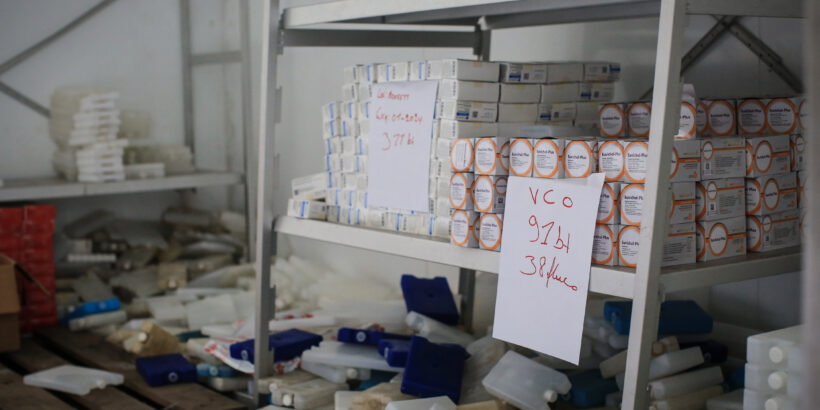Appropriate antibiotics, which first became available in the 1940s, are the only effective way to treat typhoid. The disease is caused by a quickly-evolving bacterium that has developed defenses against these drugs. The proportion of typhoid cases that are resistant to one or more antibiotics is increasing globally. Recent data show that even newer antibiotics that were once effective against typhoid are now becoming less effective, particularly in low- and lower-middle-income countries where accurate diagnosis and appropriate treatment are difficult to access. The recent emergence of a new form of superbug, extensively drug-resistant (XDR) typhoid, suggests that current antimicrobials may not be able to successfully treat typhoid for much longer.
A growing threat
Multidrug-resistant (MDR) typhoid, defined as resistance to three first-line antibiotics used to treat typhoid—chloramphenicol, ampicillin, and cotrimoxazole— first appeared in the 1970s and has since spread globally. Of particular concern is a MDR strain of typhoid called H58, which has been identified in many parts of Asia, sub-Saharan Africa, and most recently, Latin America. Given its widespread prevalence, the H58 strain is considered the globally dominant strain of MDR typhoid.
In response to MDR typhoid, a different class of antibiotics, called fluoroquinolones, became the preferred treatment regimen in the 1990s. As fluoroquinolones were used more frequently, however, typhoid again adapted, leading to emergence of fluoroquinolone-resistant typhoid strains, which are widespread in South Asia. This development has left azithromycin and third-generation cephalosporins as preferred treatment options. Alarmingly, in 2016, researchers first identified XDR typhoid in Pakistan. These strains are resistant to five classes of antibiotics: chloramphenicol, ampicillin, cotrimoxazole, streptomycin, fluoroquinolones, and third-generation cephalosporins. This leaves only one oral antibiotic, azithromycin, that is effective in treating XDR typhoid patients; however, azithromycin resistance is now also emerging. Most typhoid cases in Sindh Province, Pakistan, where XDR first emerged, are now XDR. This increases concerns around no longer having effective, oral antibiotic treatments.
Intravenous antibiotics, which are required in advanced, severe cases, are more expensive and less readily accessible, placing greater costs and pressure on public health systems in low-income countries. When effective antibiotics are inaccessible, typhoid becomes untreatable. Currently, if left untreated, 10 to 20 percent of typhoid cases can be fatal due to resulting complications.
Prevention: A proven tool
Increasing rates drug-resistant typhoid highlight the urgency for preventative measures such as typhoid conjugate vaccines (TCVs) and improved water, sanitation, and hygiene. TCVs, which can be given to children as young as six months, can have a major role in both reducing the burden of typhoid and preventing the spread of drug-resistant typhoid strains. TCVs are highly effective against XDR typhoid; In Hyderabad, Pakistan, TCV was found to be 97% effective against XDR typhoid in an outbreak setting. Additionally, a recent modeling analysis projects that TCV introduction with catch up campaigns could drastically reduce the number of drug-resistant typhoid cases and deaths. The analysis predicts that two-thirds of cases and deaths due to fluroquinolone resistant- and multidrug-resistant typhoid could be averted through TCV introduction and the proportion of typhoid cases that are drug resistant could decrease by more than 16% in Gavi, the Vaccine Alliance-eligible countries over ten years. Another modeling analysis projects TCVs to be one of the most impactful vaccines for preventing drug-resistance-associated deaths. TCVs could prevent 28,700 drug-resistance-associated deaths each year in children younger than 15 years old. By protecting the most vulnerable, we enable children to grow and thrive, limiting the development and spread of drug-resistant typhoid, as well as extending the lifespan of existing treatment options for those who do fall ill.
A global fight
Efforts to prevent drug-resistant typhoid represent part of a larger global effort against all forms of antimicrobial resistance (AMR). The World Health Organization (WHO) is leading the global conversation on AMR. In 2015, the World Health Assembly (WHA) endorsed a global action plan to tackle AMR; the action plan focuses on prevention, surveillance, and research. As part of the WHA resolution, all member states were urged to develop their own national action plans to combat AMR. As of 2023, many countries had national AMR plans in place, and some countries had identified funding sources and began implementation. Too many countries, however, are still working to develop and finalize a plan to combat AMR.
WHO has also released an updated list of Critically Important Antimicrobials and has provided new antimicrobial use guidelines in the 2019 and 2021 revisions of WHO Model List of Essential Medicines. This work is to ensure that all antimicrobials are used appropriately.
Additionally, the pipeline to develop new antibiotics is weak. To help accelerate the development of new and improved antibiotics to tackle drug-resistant infections, WHO and the Drugs for Neglected Diseases Initiative (DNDi) established a non-profit research and development organization called the Global Antibiotic Research and Development Partnership (GARDP). GARDP is working with more than 50 public and private sector partners in 20 countries to develop and deliver five new antibiotic therapies by 2025, although these are not necessarily intended to combat drug-resistant typhoid.
In response to the growing threat of drug-resistant typhoid specifically, The Global Typhoid Genomics Consortium (GTGC) was established to unite the typhoid research community to consolidate available genomic data. The consortium seeks to enhance the visibility of drug resistance to inform public health policy and action for typhoid control using genome-derived data. TyphiNET, an interactive data visualization tool, provides country-level summaries on drug-resistant typhoid and trends to better understand the emergence and spread of drug-resistant typhoid and support decision-making for TCV introduction.
Photo: PATH/Yves Ndjadi.



